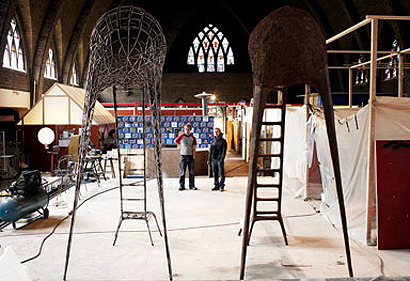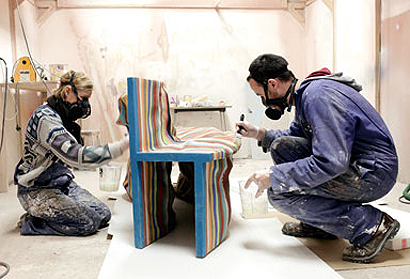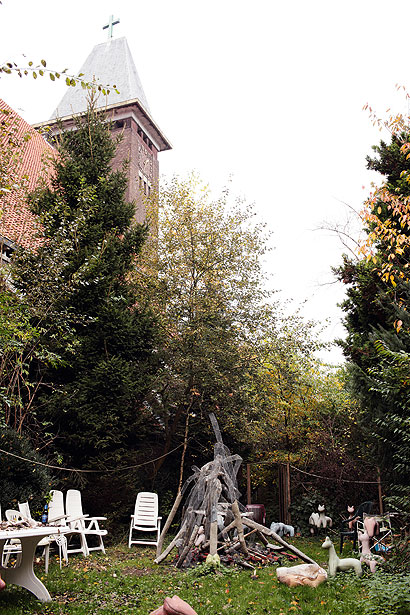|
Atelierdorp will be evicted in January.For three years, 35 designers have lived rent-free at the Pastoor van Arskerk in Eindhoven. But next month they will be turned out onto the street so that this 1930s church can be turned into a school. They don’t know where they will go. This space has seen them through a crucial moment in their careers, but it looks like it could be the end for the design collective. It’s a situation that haunts young designers all over the world – the search for a place to work. This is not just a question of shelter. Where you work decides who you work with, the collaborations you form, the influences that shape you. In the Netherlands, these arrangements are determined by the country’s generous squatting laws. Designers have the luxury of plentiful free space, but under the uncertainty of short-notice evictions. This precarious existence is starting to put its strain on the delicate dynamic that Atelierdorp is built on. It is a bright Sunday morning in October, around the time of Sunday mass, but they don’t celebrate mass in the Pastoor van Arskerk any more. The Catholic church is an impressive brick building that towers over the Eindhoven suburb of Woensel. For decades it was the heart of the community, the congregation made up of workers from the nearby Philips factory. But an increasingly secular society had less and less use for a space devoted to worship. Today, the cavernous nave is filled with simple huts made from plastic sheeting stapled to wooden frames. It looks like a little village arranged around a central walkway where the nave used to be – Atelierdorp means “studio village”. There is a welding machine under the pulpit and the sacristy has been turned into a sewing studio. But come January none of this industrious mess will be here any more. “It was like a dream to enter this place,” says French designer Julien Carretero, a designer whose large and messy ceramic work forced him to find an alternative workspace to the one offered at the Design Academy Eindhoven. “In my own country this would be close to impossible,” he says. Many of Atelierdorp’s inhabitants have come here for similar reasons – they needed room to be creative. Nacho Carbonell is another member of the collective and the altar is currently home to a collection of his Evolution series of seats and slides in different stages of completion. It is not difficult to see that his work would look imposing in any other space, but here, in the bombastic church, illuminated by the stained-glass windows, they look almost insignificant. His personal hut is a cosy mess of experiments in plant-based materials and his rudimentarily ventilated rubber workshop contains a whole army of miniature animal model experiments. “This space has opened up so many possibilities in terms of doing things,” says Carbonell. The sheer size of the place emboldened Carbonell and Carretero and gave them confidence. The concept of Atelierdorp came about three and a half years ago when ceramic designer Djim Berger, craftswoman Vera Teunen and carpenter Hilbert Tjalkens had been given two weeks notice to move out of the army barracks where they lived and worked with several other design students. Having to downsize radically and fuelled by anger at a situation that was out of their hands, they started a bonfire with all the things they could no longer keep. (Berger had, for example, collected more than 1,100 surfing sails to make bags from.) The fire burned for 12 days and nights and as it turned to ashes they made a plan. “We were not satisfied with the fact that Eindhoven promotes itself as a design city when they don’t make an effort to keep the designers here,” says Berger. To protest, they occupied an abandoned office block, attracting the attention of the mayor and the national media. Some days after the demonstration the property developer Woonbedrijf came with an offer they couldn’t refuse: an empty church where they could build their own studios. Five people moved into Pastoor van Arskerk in the autumn of 2006 and it took them almost four months to make the church habitable. They had to install a kitchen and bathroom and build their own studios. “We were originally ten but when we realised how much we had to do some people pulled out,” says Berger. It made the church a very empty place and not everyone with a studio spent all their time there. When Carbonell and Carretero joined the collective they recall spending many lonely nights in the ghostly church finding themselves yearning for the community spirit to kick in. One difficult moment is particularly vivid to Carretero: he had to varnish his Drag lights and vases day and night to complete his work on time for an exhibition at the Moss gallery in New York. It was winter and minus 17 outside and only three above zero inside. “To varnish I need a temperature of between 15 and 25 degrees and I had five heaters running all night in my studio space just to keep that temperature.” But within 18 months, Atelierdorp had grown to 35 people. “For a year we thought we were 25 but I had to make a count for a recent exhibition and realised that we were in fact 35,” says Carretero. “For me, the church took its character in June 2008. We had a lot of people then and it really changed the atmosphere and it has stayed like that since.” Around the same time Atelierdorp acquired the adjoining vicarage, adding a dimension of domesticity in contrast to the industrious church, literally sucking people into the collective. Nowadays there is always a conversation in the dining room or someone cooking in the kitchen. This morning, as the kitchen is bathed in autumn sunlight and the aroma of freshly brewed coffee, researcher and designer Veronique Lorne and product designer Charlotte Dumoncel d’Argence are sitting at the kitchen table chatting about a party the night before. It’s a picture of oddball domesticity: a cosy disarray of mismatched chairs and tables, flaking paint and a family consisting of designers from four different countries. That is how they refer to themselves now, “family”. Running Atelierdorp as a well-functioning collective is one of its biggest achievements; the byproduct of this collective isn’t just the designer’s work but the relationships and bonds that have developed. With change coming, emotions are running high, which has a direct effect on the day-to-day operation of Atelierdorp. “We have many fights about everything, especially cleaning the kitchen and sharing the space but they are healthy fights that improve the space and the collective,” says designer Bas van Reey. “Friction is a good thing, otherwise it becomes a cold place.” But just as the collective came together, now it risks coming apart. The person charged with finding a new home for this sprawling family is van Reey. With his artist girlfriend Elle Reumkens, they ran Atelierdorp’s old premises. Their office, in the attic of the vicarage, is filled with bean bags – it’s also used as the relaxation room. “Nacho and I were big fans of having a relaxation room,” says Reey. “You need to lay down for a little while now and then, especially when you work late. I will make sure that this continues in the new space.” Unlike some of the other members of the collective, Reey is optimistic about the future. He is convinced that they will find a space big enough to house all of them again. We talk the day before he is due to have the last and very crucial meeting with the city council about Atelierdorp’s options. It would be normal for such a meeting to bring on some nerves, but Reey is reflective. “I ask myself the question if it’s important that we are in a church. If it has any impact on us and the work, but I realise that the group is stronger than the building,” says Reey. “Obviously the idea of a designer’s work coming out of a church conjures up interesting pictures, so I’m looking for a new space with similar connotations, in fact, I have my eye on an old matchstick factory. I think that could work.” After the meeting, I call Reey again to ask how it went. “We’ve been offered two possible spaces,” he says. “One is a school, the other an old army barracks.” He still sounds positive but there is a hint of disappointment in his voice. The offer, which is not confirmed yet, highlights the unique environment that Atelierdorp has existed in until now. It seems that no matter how trying the last few months have been they are all certain that they want to move on together. “We want to keep Atelierdorp as it is, and we want to move as a group. It makes it difficult but it is also a strength,” says Carretero. Nacho Carbonell adds a bit of gallows humour to the situation. “Hopefully we will find a space for 35 friends to meet again. Or maybe you will see us on the street begging with all of our things!”
Nacho Carbonell’s Evolution pieces at the altar
The hallway of the vicarage
Julien Carretero and his assistant painting
The garden and church tower |
Image Raoul Kramer/Collective Exposure Words Johanna Agerman |
|
|




















